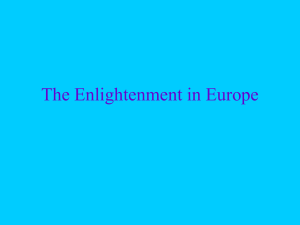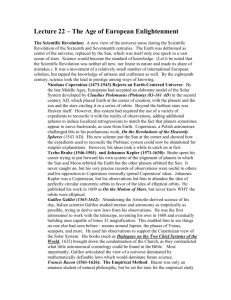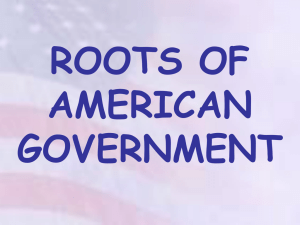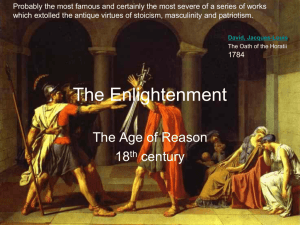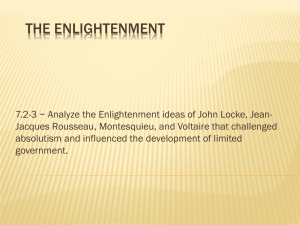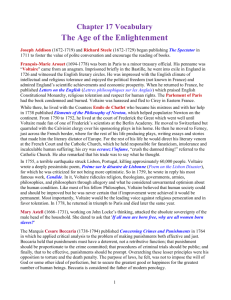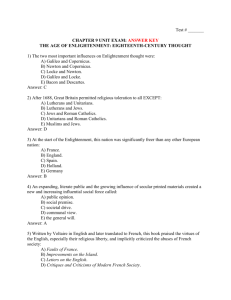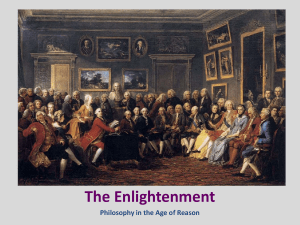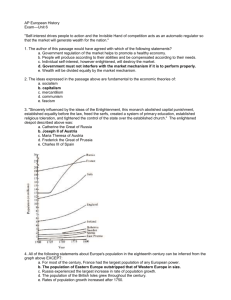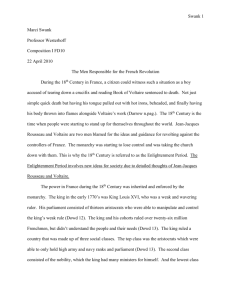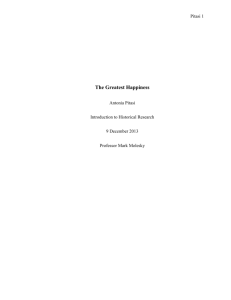Worksheet
advertisement
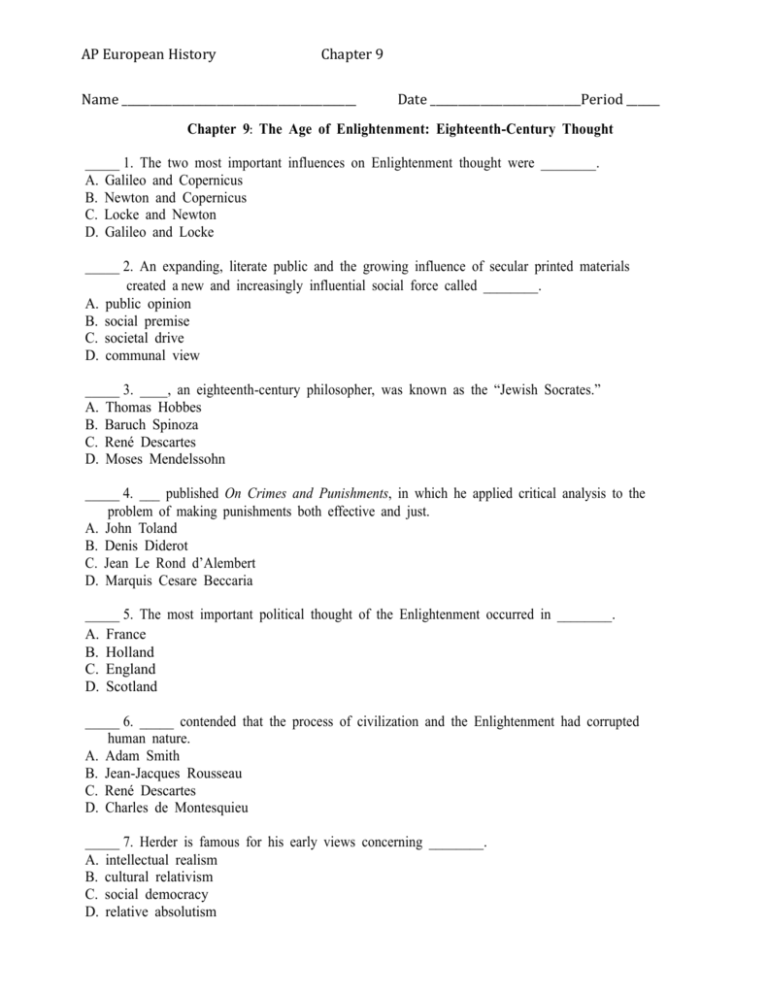
AP European History Chapter 9 Name __________________________________________ Date ___________________________Period ______ Chapter 9: The Age of Enlightenment: Eighteenth-Century Thought _____ 1. The two most important influences on Enlightenment thought were ________. A. Galileo and Copernicus B. Newton and Copernicus C. Locke and Newton D. Galileo and Locke _____ 2. An expanding, literate public and the growing influence of secular printed materials created a new and increasingly influential social force called ________. A. public opinion B. social premise C. societal drive D. communal view _____ 3. ____, an eighteenth-century philosopher, was known as the “Jewish Socrates.” A. Thomas Hobbes B. Baruch Spinoza C. René Descartes D. Moses Mendelssohn _____ 4. ___ published On Crimes and Punishments, in which he applied critical analysis to the problem of making punishments both effective and just. A. John Toland B. Denis Diderot C. Jean Le Rond d’Alembert D. Marquis Cesare Beccaria _____ 5. The most important political thought of the Enlightenment occurred in ________. A. France B. Holland C. England D. Scotland _____ 6. _____ contended that the process of civilization and the Enlightenment had corrupted human nature. A. Adam Smith B. Jean-Jacques Rousseau C. René Descartes D. Charles de Montesquieu _____ 7. Herder is famous for his early views concerning ________. A. intellectual realism B. cultural relativism C. social democracy D. relative absolutism AP European History Chapter 9 _____ 8. ___ maintained that women were not naturally inferior to men and that women should have a wider role in society. A. Adam Smith B. Jean-Jacques Rousseau C. René Descartes D. Charles de Montesquieu _____9. Which of the following styles of art utilizes lavish, often lighthearted decoration with an emphasis on pastel colors and the play of light? A. baroque B. Rococo C. Impressionism D. Neoclassicism _____10. Which of the following styles of art embodies a return to figurative and architectural drawn from the Renaissance and the ancient world? A. Rococo C. Impressionism B. abstract D. Neoclassicism _____11. _____, who embodied enlightened absolutism more than any other monarch, forged a state that commanded the loyalty of the military, the Junker nobility, the Lutheran clergy, and a growing bureaucracy. A. Joseph II C. Frederick the Great B. Maria Theresa D. Catherine II _____12. As part of her territorial aspirations, Catherine the Great painlessly annexed the newly independent state of ________ in 1783. A. Estonia C. Livonia B. Crimea D. Romania _____13. How did Voltaire come to admire English culture? A. He read the works of English philosophes. B. He visited England on holiday. C. He was the French ambassador to England. D. He lived in exile in England. _____14. The issue most relevant to physiocrats was ________. A. legal reform C. legislative reform B. women’s social status D. property rights _____15. The subject matter of Rococo style paintings with scenes of leisure, romance and seduction led to a feeling of hostility toward the ________. A. political and social elites of the Old Regime B. nobles at court C. monarchy D. peasantry modes AP European History Chapter 9 _____ 16. Who believed that the intent of punishment should be to deter further crime, not to impose the will of God? A. Voltaire B. Jean-Jacques Rousseau C. Mary Wollstonecraft D. Marquis Cesare Beccaria _____17. From where did the first imports of coffee come to supply the European coffeehouses? A. from Brazil C. from Africa B. from the Caribbean D. from the Ottoman Empire _____ 18. Which of the following philosophes argued against the abuses of imperialism? A. Moses Mendelsohn C. Adam Smith B. Immanuel Kant D. Cesare Beccaria _____ 19. Which philosophe is credited with a profound effect on the constitutional form of liberal democracies for more than two centuries? A. Charles de Montesquieu C. Baruch Spinoza B. Voltaire D. Jean-Jacques Rousseau _____ 20. When Immanuel Kant called his age “an age of Enlightenment,” he stressed the Enlightenment as _________. A. the highest stage of achievement C. the past D. a work in progress B. Adam Smith’s fourth stage _____ 21. The two major points in the deists’ creed were ________. A. the belief in an afterlife dependent upon one’s earthly actions and the existence of a rational God B. the belief in the existence of a rational God and the existence of absolute principles C. the belief in an afterlife dependent upon one’s earthly actions and the existence of absolute principles D. the belief in the existence of absolute principles and the illogical nature of God’s existence _____ 22. Montesquieu hoped to counter monarchical oppression with ________. A. democracy B. independent branches of government C. a legislative body that would head the government D. a theocracy _____ 23. What was the purpose of Voltaire’s interest in the execution of Jean Calas? A. Voltaire wished to demonstrate the horror of religious fanaticism and the need for judicial reform. B. Voltaire was related to Jean Calas and wished to clear his name. C. Voltaire was hired by the family of Calas to clear his name after he was executed. D. Voltaire wanted to demonstrate that religious goals would find the truth in the end. AP European History Chapter 9 _____ 24. The Encyclopedia ________. A. secularized learning and spread Enlightenment ideas throughout Europe B. sold about 1,200 copies C. received official support D. was written by Denis Diderot and Jean Le Rond d’Alembert _____ 25. According to Smith’s four-stage theory, human societies ________. A. have no real moral basis B. can be religious, secular, scientific, or superstitious C. move from barbarism to civilization D. can be classified as hunter-gatherer, pastoral, agricultural, or knowledge-worker _____ 26. Which connection between work and author is accurate? A. Theologico-Political Treatise: Mendelsohn B. Persian Letters: Montesquieu C. Encyclopedia: Spinoza D. Candide: Diderot _____ 27. Most European thinkers associated with the Enlightenment ________. A. favored the extension of European empires across the world B. were members of the artisan class C. were proponents of democracy D. were atheists _____ 28. The philosophes generally ________. A. advocated fundamental changes in the social condition of women B. believed women to be socially equal but not politically equal to men C. said little about women D. were not avid feminists _____29. Neoclassical paintings were didactic rather than emotional, and their subject matter usually concerned ________. A. public life or public morals B. intimate family life C. daily routines D. leisure activities _____30. Monarchs such as Joseph II and Catherine II made “enlightened” reforms part of their drive to ________. A. increase revenues and gain political support B. begin the process of moving away from monarchy C. begin the process of moving toward constitutional monarchy D. give commoners more political power _____ 31. The monarch that most exemplifies enlightened absolutism was ________. A. Joseph II C. Frederick the Great B. Maria Theresa D. Catherine II AP European History Chapter 9 _____32. Of all the rising states of the eighteenth century, ________ was the most diverse in its people and problems. A. Austria C. Prussia D. France B. Russia _____ 33. Joseph II of Austria ________. A. sought to improve the productivity and social conditions of the peasantry B. increased the tax burden on the peasantry C. reduced the serfs to slaves D. built many Catholic seminaries and allowed the church total autonomy _____34. The ideas of Mary Wortley Montagu differed from most contemporary European writers thinkers because she ________. A. had read Persian poetry extensively B. had first-hand knowledge of the Muslim world C. approached Islam through comparison with Christianity D. had been raised Muslim _____ 35. Deism reflected Enlightenment intellectual currents in ___________. A. rejecting the notion of a deity B. its rational approach C. having a special role for women in its observations D. its opposition to Islam _____36. Which statement best summarizes Rousseau’s writings about the role of women in society? A. Rousseau’s views had little impact on the ideas of his contemporaries. B. Rousseau’s ideas were novel and surprising for most of his readers. C. Rousseau was considered progressive and liberal in his ideas of women. D. Rousseau’s traditional ideas deeply influenced many leaders on the subject of gender roles. _____ 37. What was the effect of the Prussian Civil Service Commission? A. It subordinated the nobility and aristocracy to the state in Prussia under Frederick the Great. B. It placed the Junkers under the authority of the nobles in Prussia under Maria Theresa. C. It led to a rise in the prosperity of the middle class. D. It caused a decrease in property rights for the nobility _____38. How did print culture contribute to the Enlightenment and the call for reform throughout Europe? A. Increasing literacy and the volume of books printed encouraged the discussion of ideas about reform. B. The greater number of print shops employed a large number of people and raised the standard of life for the middle class. C. Governments were able to distribute their ideas in writing to a wider number of people. D. Reference books such as the Encyclopedia were available to most universities. and AP European History Chapter 9 _____ 39. After 1688, which of these remained oppressed in Britain? A. Lutherans and Unitarians B. Lutherans and Jews C. Jews and Roman Catholics D. Unitarians and Roman Catholics _____ 40. Philosophes were most direct in their attacks on Christian __________. A. clergy C. institutions B. beliefs D. schools _____ 41. Smith’s four-stage theory placed European culture ________. A. in the third stage B. at the summit of human achievement C. in the Enlightenment stage of development D. in a stage beyond the fourth stage _____ 42. Frederick the Great’s religious toleration can be seen as _________. A. based on practical politics B. an outgrowth of his own atheism C. an attempt to undermine the Ottoman Empire D. a weapon against Russia _____43. Catherine the Great’s reforms were ultimately dampened by which of these considerations? A. the vastness of Russia B. the expense of war with Austria C. a number of religious uprisings D. the need to placate the nobility Short Answer: 3 points each 1. Compare and contrast in detail the Rococo and neoclassical styles in eighteenth-century art. Be certain to address the history of the styles, political associations, and famous artists that emerged from both methods. Topic: Rococo and Neoclassical Styles in Eighteenth-Century Art 2. What approach did the philosophes take to organized religion? Explain their rationale. Finally, discuss how the ideas of deism resolved some of their religious objections. Topic: The Enlightenment and Religion
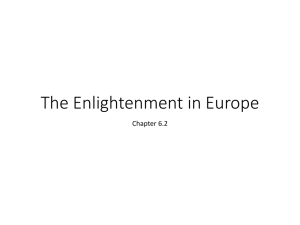
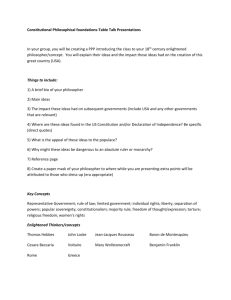
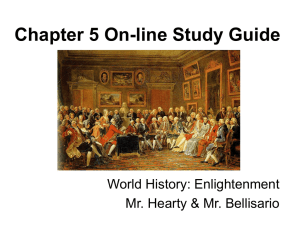
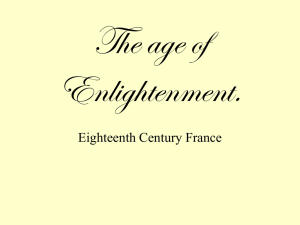
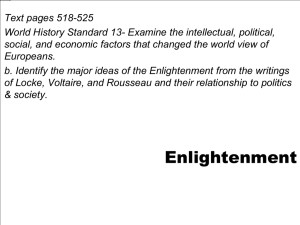
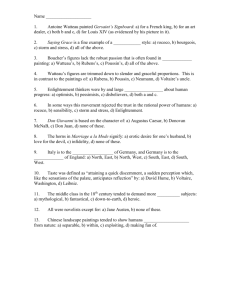
![6-2] The Enlightenment in Europe](http://s2.studylib.net/store/data/005802603_1-4aabf27e62711229ab33859d5b6ac4df-300x300.png)
